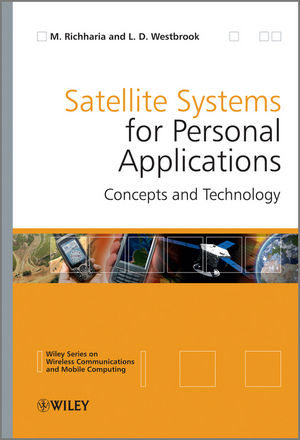Satellite Systems for Personal Applications: Concepts and TechnologyISBN: 978-0-470-71428-7
Hardcover
476 pages
August 2010
 |
||||||
Preface.
Acknowledgements.
1 Introduction.
1.1 Scope.
1.2 Perspective.
1.3 Background and Applications.
1.4 Trends.
1.5 Overview of this Book.
Part I BASIC CONCEPTS.
2 Satellites and High-Altitude Platforms.
2.1 Introduction.
2.2 Satellites.
2.3 High-Altitude Platforms.
3 Spectrum and Propagation.
3.1 Introduction.
3.2 Spectrum.
3.3 Propagation.
4 Antennas and Noise.
4.1 Introduction.
4.2 Antennas.
4.3 Noise.
5 Modulation and Coding.
5.1 Introduction.
5.2 Modulation.
5.3 Error Control Coding.
6 Satellite Access and Networking 161
6.1 Introduction 161
6.2 Satellite Access 161
6.2.1 Single Access 161
6.2.2 Multiple-Access Methods 165
Contents vii
6.2.3 Random Access 166
6.2.4 FDM and FDMA 167
6.2.5 SDMA (Frequency Reuse) 172
6.2.6 TDM and TDMA 173
6.2.7 CDM and CDMA 176
6.3 Payloads 181
6.3.1 Unprocessed Payloads 181
6.3.2 Processed Payloads 182
6.4 Networks 184
6.4.1 Network Architectures 184
6.4.2 Network Models 185
Revision Questions 191
References 191
7 Doppler and Pseudorange (Navigation) 193
7.1 Introduction 193
7.2 Doppler 194
7.2.1 Doppler Shift 194
7.2.2 Position Location Using the Doppler Shift 194
7.3 Pseudoranging 198
7.3.1 Pseudorange 198
7.3.2 Position Determination Using Ranging 199
8 Compression, Speech, Audio and Video Encoding.
8.1 Introduction.
8.2 Lossless Data Compression.
8.3 Digitizing Analogue Signals.
8.4 Speech Encoding.
8.5 Audio Encoding.
8.6 Video Encoding.
Part II TECHNIQUES AND SYSTEMS.
9 Digital Broadcasting Techniques and Architectures.
9.1 Introduction.
9.2 MPEG Multimedia Standards.
9.3 Direct-to-Home Broadcast System.
9.4 Direct Broadcasts to Individuals and Mobile Users.
9.5 Military.
10 Broadcast Systems.
10.1 Introduction.
10.2 Satellite Radio Systems.
10.3 Direct Multimedia Broadcast.
10.4 Direct-to-Home Television.
10.5 Military Multimedia Broadcasts.
11 Communications Architectures.
11.1 Introduction.
11.2 Role.
11.3 Circuit-Switched Services.
11.4 Packet-Switched and Converged Services.
11.5 Satellite Communications Networks.
11.6 High-Altitude Platform Systems.
12 Satellite Communications Systems.
12.1 Introduction.
12.2 Mobile Communications.
12.3 Fixed Communications.
12.4 Military Communications.
12.5 Amateur Communications.
12.6 HAP Communications.
13 Satellite Navigation Techniques.
13.1 Introduction.
13.2 Categorization.
13.3 Doppler-Assisted Navigation.
13.4 Range-Assisted Navigation.
13.5 Satellite Augmentation System.
13.6 Navigation–Communication Hybrid Architecture.
13.7 Receiver Architecture.
13.8 Distress, Safety and Location-Based Services.
14 Navigation, Tracking and Safety Systems.
14.1 Introduction.
14.2 Global Navigation Satellite Systems.
14.3 Regional Navigation Systems.
14.4 Satellite-Based Augmentation Systems.
14.5 Distress and Safety.
14.6 Location-Based service.
15 Remote Sensing Techniques.
15.1 Introduction.
15.2 Remote Sensing Data.
15.3 Sensors.
15.4 Image Processing.
15.5 Image Interpretation.
15.6 System Characteristics.
16 Remote Sensing Systems.
16.1 Introduction.
16.2 Commercial Imaging.
16.3 Meteorology.
16.4 Land Observation.
17 The Future.
17.1 Introduction.
17.2 Influences.
17.3 Trend.
17.4 The Long Term.
17.5 Satellites and the Environment.
17.6 Conclusion.
Appendix A List of Personal Applications.
Index.



